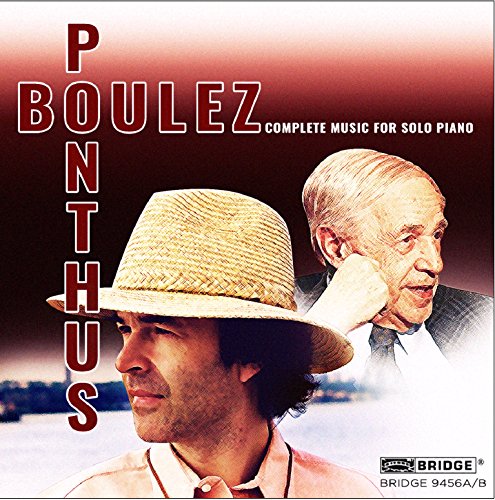BOULEZ Complete Piano Music
View record and artist detailsRecord and Artist Details
Composer or Director: Pierre Boulez
Genre:
Instrumental
Label: Bridge
Magazine Review Date: 04/2016
Media Format: CD or Download
Media Runtime: 81
Mastering:
DDD
Catalogue Number: BRIDGE9456A/B

Tracks:
| Composition | Artist Credit |
|---|---|
| Sonata for Piano No. 2 |
Pierre Boulez, Composer
Marc Ponthus, Piano Pierre Boulez, Composer |
| (12) Notations |
Pierre Boulez, Composer
Marc Ponthus, Piano Pierre Boulez, Composer |
| Incises |
Pierre Boulez, Composer
Marc Ponthus, Piano Pierre Boulez, Composer |
| Sonata for Piano No. 1 |
Pierre Boulez, Composer
Marc Ponthus, Piano Pierre Boulez, Composer |
| Une page d'éphéméride |
Pierre Boulez, Composer
Marc Ponthus, Piano Pierre Boulez, Composer |
| Sonata for Piano No. 3 |
Pierre Boulez, Composer
Marc Ponthus, Piano Pierre Boulez, Composer |
Author: Philip Clark
The ghosts of Maurizio Pollini, Charles Rosen and Claude Helffer – if not necessarily Idil Biret on Naxos and DG’s Paavali Jumppanen – hang heavy, of course, and Vassilakis and Ponthus are representatives of a new generation of Boulez interpreters, alongside Pi-Hsien Chen, whose 2005 release on HatArt (the three sonatas and Notations only) remains giddyingly brilliant. Chen is broadly faithful to the music’s modernist idiom. There are moments during Vassilakis’s set when you feel a conscious (re-)positioning of the music towards embracing earlier traditions in French piano music; and, rather neatly, Ponthus pitches his aesthetic tent equidistant between these two approaches, his pianism engaging fully with what this music can do, rather than just what it is.
Chatter persists, including from those who should who better, that making a judgement about which recording of Boulez’s piano music to choose is a pointless task as only bat (or Boulez) ears could distinguish right notes from wrong. But Ponthus opens with the Second Sonata, immediately imposing character and definition on the music. His high-velocity vault through the opening movement – marked Extrêmement rapide – takes Boulez at his word, coming in a whole two minutes faster than Chen (5'22" against 7'39") and making even Pollini sound overly deliberate. But Ponthus doesn’t just have quicksilver fingers. The phrasing, the harmonic evolution and the music’s rhythmic inner engine spark into intelligent life; he voyages deep inside the music’s journey, the desolate and sparse weave of the second movement’s beginning feeling not only logical but musically necessary.
His unpicking of the Third Sonata’s modular structure corroborates my intuition that Ponthus has the Second Sonata’s four-movement construct entirely under his control. Subtle nuances of timbre and harmonic urgency stress that the Third Sonata is an unfolding and living structure that ought not solidify into a form. In comparison, Incises and Une page d’ephéméride resonate as pretty enough doodles; but the First Sonata and the kaleidoscopic Douze Notations feel suitably packed with variety and event. As a postscript, I’m duty bound to comment that Bridge’s hilariously terrible cover art might actively dissuade some potential punters – a recurring Achilles heel that this otherwise consistently excellent label urgently needs to address.
Discover the world's largest classical music catalogue with Presto Music.

Gramophone Digital Club
- Digital Edition
- Digital Archive
- Reviews Database
- Full website access
From £8.75 / month
Subscribe
Gramophone Full Club
- Print Edition
- Digital Edition
- Digital Archive
- Reviews Database
- Full website access
From £11.00 / month
Subscribe
If you are a library, university or other organisation that would be interested in an institutional subscription to Gramophone please click here for further information.




